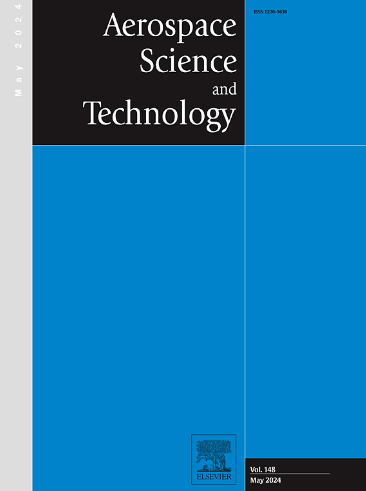Pressure-sensitive paint measurements in transonic backward-facing step flow
IF 5
1区 工程技术
Q1 ENGINEERING, AEROSPACE
引用次数: 0
Abstract
This study investigates the distribution of pressure around a 5-mm-high backward-facing step model and counter-rotating vane vortex generators in a transonic wind tunnel by applying pressure-sensitive paint. Vortex generators with heights of 0.0, 0.2, 0.5, and 1.0 relative to the thickness of the turbulent boundary layer were used under transonic flow conditions at Mach numbers of 0.8 and 0.9. Oil flow visualization results were found to be similar to those of the pressure-sensitive paint measurements in terms of reattachment length and flow characteristics. This direct comparison not only confirms the reliability of PSP but also demonstrates its superior ability to visualize complex pressure distributions. Although the oil flow visualization technique effectively depicted the flow patterns, the pressure-sensitive paint approach provided more detailed information by depicting two-dimensional pressure distributions and identifying low-pressure regions around the vortex generators. Among all configurations, the vortex generator with h* = 0.5 was found to be the most effective in shortening the recirculation region and advancing the reattachment point under both Mach numbers.跨声速后向阶跃流压敏涂料测量
采用压敏涂料研究了跨声速风洞中5 mm高后向台阶模型和反向旋转叶片涡发生器周围的压力分布。在马赫数为0.8和0.9的跨声速流动条件下,采用相对于湍流边界层厚度高度分别为0.0、0.2、0.5和1.0的涡发生器。油流可视化结果与压力敏感涂料测量结果在再附着长度和流动特性方面相似。这种直接比较不仅证实了PSP的可靠性,而且证明了它在可视化复杂压力分布方面的优越能力。尽管油流可视化技术有效地描绘了流动模式,但压力敏感涂料方法通过描绘二维压力分布和识别涡流发生器周围的低压区域,提供了更详细的信息。在所有构型中,在两个马赫数下,h* = 0.5的涡发生器在缩短再循环区域和推进再附着点方面效果最好。
本文章由计算机程序翻译,如有差异,请以英文原文为准。
求助全文
约1分钟内获得全文
求助全文
来源期刊

Aerospace Science and Technology
工程技术-工程:宇航
CiteScore
10.30
自引率
28.60%
发文量
654
审稿时长
54 days
期刊介绍:
Aerospace Science and Technology publishes articles of outstanding scientific quality. Each article is reviewed by two referees. The journal welcomes papers from a wide range of countries. This journal publishes original papers, review articles and short communications related to all fields of aerospace research, fundamental and applied, potential applications of which are clearly related to:
• The design and the manufacture of aircraft, helicopters, missiles, launchers and satellites
• The control of their environment
• The study of various systems they are involved in, as supports or as targets.
Authors are invited to submit papers on new advances in the following topics to aerospace applications:
• Fluid dynamics
• Energetics and propulsion
• Materials and structures
• Flight mechanics
• Navigation, guidance and control
• Acoustics
• Optics
• Electromagnetism and radar
• Signal and image processing
• Information processing
• Data fusion
• Decision aid
• Human behaviour
• Robotics and intelligent systems
• Complex system engineering.
Etc.
 求助内容:
求助内容: 应助结果提醒方式:
应助结果提醒方式:


